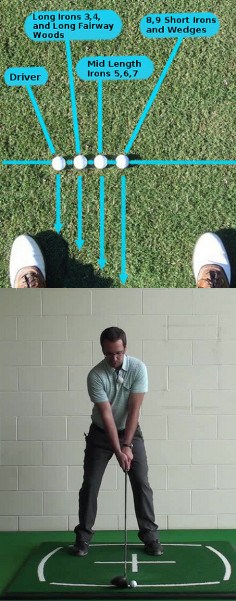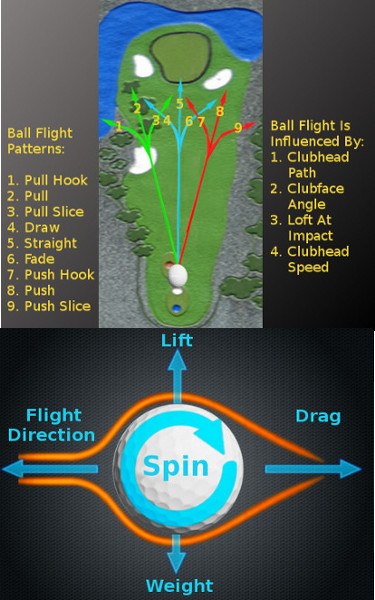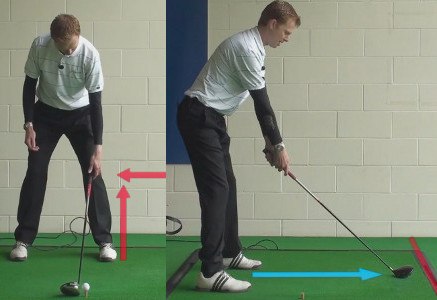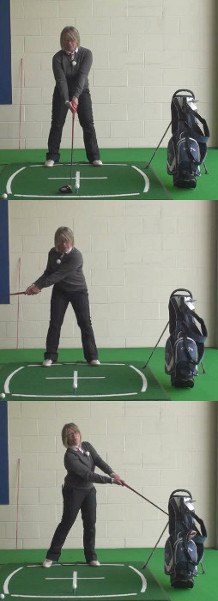
“Tee it high and let it fly” is a great mantra for driving the ball, but what if your shots barely get off the ground?
Low trajectory is a common affliction among golfers who lack clubhead speed, but even powerful players sometimes hit the ball lower than they’d like. Let’s tackle some causes and cures for both groups.
Cure: Weaken your grip – Without squeezing the club, turn both hands to your left until two knuckles are visible on the back of your left hand. This is a more “neutral” position that will allow the clubface to open into a square position on the backswing. If your grip doesn’t require adjusting, make sure to rotate the forearms and hands as you swing the club back.

Quit Hitting Your Drives Too Low and Add Yards Immediately
There are plenty of reasons for the average amateur golfer to be jealous of the professionals they see playing on TV. After all, those pros frequently win prizes of more than $1 million while playing a game that they love. Despite all of the hard work that goes into being a professional golfer, the lifestyle is one that most amateur players would love to experience.
Putting aside the financial benefits of playing at the highest level, many golfers are simply jealous of the way that the professionals are able to hit the ball. Most of them make swings that seem free and effortless, yet the ball rockets into the sky with incredible power and velocity. Drives of 300 yards or more are commonplace on pro golf tours around the world today. So how do they do it? One key element is that the professionals generally hit the ball much higher off the tee than do their amateur counterparts.
Getting the optimal driver trajectory off the tee is one of the key elements to maximizing distance.
Obviously you need great swing speed to hit long drives, but that speed can easily be wasted if you don’t have the right driver trajectory. Optimal trajectory is a combination of a few elements, most notably launch angle and spin rate. The launch angle that you get on your tee shots is the upward angle at which the ball leaves the club face, relative to the ground. So, for example, a 0* launch angle would be a shot that never leaves the ground, and a 90* launch angle would be a shot that goes completely vertical up into the air. While the ideal launch angle for you is going to depend on the specifics of your swing, most golfers are going to want to land somewhere between 10* - 15*.
Spin rate is exactly as it sounds – the rate of spin that is put on the ball by your driver as it leaves the club face. Again, the ideal spin rate is going to vary based on your launch angle, swing speed, and more. However, lower is generally better, as long as you have enough spin to keep the ball in the air as it travels down the fairway. Too much spin will cause your shots to balloon and lose distance, but too little spin won’t allow them to have enough carry. In terms of raw numbers, most players will benefit from keeping the spin rate between 1800 – 3000 rpm’s. Too far on either side of that range and you will likely lost distance as a result.
Getting back to the question at hand, ‘how to hit the ball higher with by driver’? A lot of it is going to come down to getting a good handle on those two variable discussed above – launch angle and spin rate. If you are currently struggling to get sufficient height on your tee shots, it is likely because you have a launch angle and spin rate that are both too low. Raising either of these numbers should help your ball flight, and raising both of them (but not too much) should allow you to maximize your distance. There are both swing adjustments and equipment changes that you can make to reach your trajectory goals off the tee.
All of the golf swing tips to improve driver trajectory that are included below have been written for a right handed golfer. Should you happen to be a left handed player, please make sure to reverse the instructions so that they apply properly to your swing.

The Basics behind Your Ball Flight
In order to correct your low ball flight with the driver, you first need to understand what is happening to make the ball fly too low in the first place. Understanding the basic dynamics of ball flight is helpful for any golfer, but especially one who wants to get their driver higher into the air so it can fly farther down the fairway. Not to worry – you don’t have to be a science professor to understand what is going on with the golf ball. Read through the following points related to ball flight in golf and you will quickly have a better understand of what you should be trying to do in your swing.
- Spin makes the ball climb. While the launch angle of your shots determines the initial height of the ball flight, it is the backspin that you put on the ball that really determines the trajectory. If a shot has too little spin, it will remain close to the ground and take a ‘flat’ trajectory toward the target. Too much spin, however, will cause it to climb high into the air quickly, and it will likely fall short of where you expected it to land. The ideal amount of spin combines these two so the ball will hang in the air and travel the maximum distance down the fairway.
- Descending blow is only for irons. Hitting down into your irons shots is a great thing because it imparts spin onto the ball and allows the loft of the club to do the work of getting the shot high into the air. However, that concept does not translate to the driver. Instead, you want to be hitting up on your driver, using the advantage that the tee is giving you. Sweeping up into the ball will reduce the amount of spin that you achieve on the shot and give you the best chance of finding that perfect 10*-15* launch angle that most players should be looking for. If you are hitting down too much on your iron shots currently, you are probably hitting shots with such a low launch angle that the ball remains low to the ground even if you have plenty of spin. Fix the attack angle into the shot and you will quickly raise the ball flight.
- Hit through the shot. You need to have plenty of speed as you are coming into impact if you want to get the ball high into the air. One of the best golf swing tips to improve driver trajectory that you can get is simply to swing all the way through the shot with no hesitation at impact. Too many golfers struggle with a lack of confidence as they get toward impact, so they slow down their swing in fear of hitting a bad shot. Obviously, this is going to lead to poor results. Instead, make a confident swing and accelerate the club all the way through the hitting area to a full finish. You aren’t going to hit a great shot every time, but you will be far more successful this way than if you doubt yourself at the last moment.
Golfers who are fighting a low ball flight off the tee can quickly improve their performance by just paying attention to the three points above. Combining an ascending blow into the ball with plenty of speed should lead to a shot that floats well up into the air. It might not yet be your ideal ball flight, but it will at least be a step in the right direction.

Making Some Swing Changes
In order to dial in the proper ball flight that will lead you to your best possible performance off the tee, you probably will need to make at least a couple adjustments to your full swing technique. Assuming you are trying to figure out ‘how to improve my golf drive height’, there are likely some flaws in your swing leading to the low shots at this point. Implementing even a couple basic changes to your form could have a major impact on what your ball flight looks like.
If you are fighting a golf driver ball trajectory too low at the moment, you are probably wasting your swing speed early in the downswing and not saving it up for impact. That leads to weak contact with the ball, and a shot that lacks the speed and spin to really get up into the air. There are a couple steps you can take to improve your ability to hold onto that club head speed until impact. The first is to change the way your lower body is working in the swing. Instead of letting your hands and arms lead the way down into the ball, you should be starting down with your lower body first. Most amateurs get this point wrong, and it is the main reason why they struggle to create the distance they are hoping for off the tee.
Making this change means altering the way you transition from backswing to downswing. Rather than starting with your hands, try starting with your legs and letting your hands trail behind. At first, this will feel quite awkward. Give it some time on the driving range and you should start to see an increase in your club head speed through the shot. Remember, however, that your lower body shouldn’t be sliding toward the target – it should simply be rotating to the left to make way for your arms and the club to swing down into the ball. It is only when you get this order of operations correct that you can truly maximize your ability to create speed.
The other swing change that you should work on making is keeping your head down and behind the ball through impact. It is very difficult to get the ball into the air properly when your head drifts past the position of the ball during the swing. This moves your center of gravity closer to the target, and means you are going to hit down through the shot instead of up into the ball. Think of this as ‘staying behind the ball’ – keep your head in a relatively stationary position and allow the club to rip through impact while your body rotates in place rather than slides to the left.
This is another one of those golf swing tips to improve driver trajectory that almost every amateur could benefit from. Sliding past the ball at impact is a common problem among the average golfer, and it robs players of both distance and accuracy. One good visual cue that could help you solve this problem is to picture yourself making your golf swing inside of a big barrel. The barrel gives you plenty of room to rotate left and right, but very little room to move side to side. This is exactly the image that you should take with you onto the driving range, and onto the course. Make your swing in an imaginary barrel and you won’t have to worry about getting your head out of position any more.
Just those two swing adjustments – leading with your lower body and keeping your head in position – should help you solve the puzzle of ‘how to hit the ball higher with my driver.’ Like any other swing tweaks that you make, take them onto the practice range first prior to going out onto the course for an actual round.

The Equipment Part of the Riddle
Your swing technique has a lot to do with how high your tee shots fly off of your driver, but that isn’t the end of the puzzle. The driver itself also plays a role in the ball flight that you get, so making sure you have the right club for your swing is an important step. It isn’t necessary to spend hundreds of dollars right away on a new driver, but playing with the right equipment is something that you will want to do if you are serious about getting better.
To make sure you have the right gear in your bag, consider the tips below.
- Go to a club fitting. By far, this is the best step you can take to make sure you have the right driver in your bag. A club fitting session with a local professional should only take about a half hour of your time, and usually isn’t very expensive to schedule. In fact, if you end up buying a driver from their shop, the fee for the session might even be refundable. Even if you don’t buy a new driver from them, your time and effort to go through the fitting will be well worth it. The session should be able to offer you information like your spin rate, ball speed, launch angle, and more. From there, the club fitting professional should be able to make recommendations regarding what changes you could make to your current equipment to optimize your ball flight.
- Try various drivers. Even if you decide not to go through a club fitting, it is still a good idea to try a few drivers at your local golf shop to see which one produces the best ball flight. It is likely that a softer-flex shaft will help you get the ball higher into the air, so be sure to try one or two with a shaft that is softer than what you currently use. A driver that hits a low ball for one golfer might hit a high drive for another, so it is worth trying them out for yourself to see the results.
- It’s not all about loft. Many golfers fall in love with the loft number on the bottom of the driver, not realizing there is far more to the height of the shot than just loft. Sure it might help to get a higher-lofted driver if you are struggling to get the ball off the ground, but your trajectory usually has much more to do with the shaft in the club than the loft that is has.
Don’t fight with a golf driver ball trajectory too low for very long without seeing if different equipment can improve the situation. Golf is a hard enough game as it is, you don’t need to be fighting your gear in addition to your swing. Take the time to get the right clubs in your bag and you might be surprised at how quickly you can improve your game as a whole.

A Few Other Tips
If you are still trying to figure out exactly ‘how to improve my golf drive height’, there are a few final tips in this section that could help you find the elevation you are looking for. These tips might seem like minor adjustments, but they can combine to make a big difference when implemented on the course.
- Tee it high enough. Many amateur golfers make the simple mistake of teeing the ball too low for the average drive. Modern drivers have large heads and the ball needs to be teed up sufficiently high in order to make contact on the sweet spot. If you tee the ball down too low, you will be forced to hit down into the shot – exactly what you should be trying to avoid. As a good rule of thumb, tee the ball up so that half of the golf ball is above the top of your driver at address. From that position, you should be able to comfortably hit up into the shot and achieve the higher flight you are wanting.
- Get the right golf ball. One other point on equipment is making sure you are playing the right golf ball for your swing. Many amateur players reach for the ball that they see their favorite Tour player using, even if they lack the swing speed to make that ball work for them. Pick out a golf ball that is designed for use by a player with your specific swing speed – it can make a huge difference to the ball flight and overall distance that you get from your shots.
- Take your time in the backswing. Tee shots that are too low can actually be caused by cutting your backswing short as well. If you don’t finish your backswing, you won’t be able to get positioned correctly behind the ball – meaning you are more likely to end up leaning left at impact and again fighting with a downward angle of attack. Don’t rush through your backswing and make sure you give it plenty of time to be completed before you transition into the forward swing.
- Keep a wide base. One final problem that can cause you to sway past the ball at impact, and hit low drives as a result, is standing with your feet too close together at address. They should be at least shoulder width apart, if not a little more prior to starting your swing. A wide base will enable you to swing aggressively and use that ‘barrel’ image that was mentioned above. Balance is key to any good golf swing, and making a wide stance will increase your chances of staying balanced all the way through the swing and into your finish position.
Successfully answering the question of ‘how to hit the ball higher with my driver’ can benefit your game in a number of ways. First, hitting low drives will always mean that you are falling short of your distance potential off the tee. Getting the ball higher into the air should mean more yardage on your drives, which will lead to shorter approach shots – and hopefully lower scores. Also, carrying the ball farther off the tee helps you to stay away from hazards like ponds or bunkers that might line the fairways. It can be helpful from time to time to know how to hit a low drive when you need one (windy conditions), but a high ball flight should be your standard shot when the weather is good.
Hopefully the information contained above will help you solve your low ball flight with the driver so you can see the ball soaring through the air in the near future. It is rarely just one issue that causes a low ball flight, so look at everything from swing mechanics to equipment to make sure you give yourself the best chance to fix this problem.






